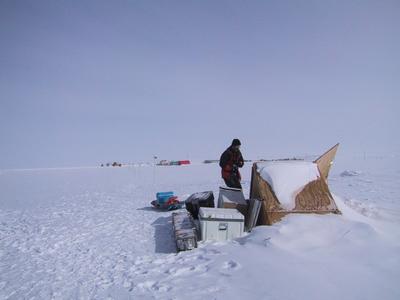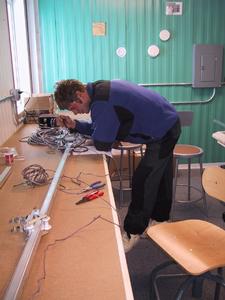26 July, 2001
Resilience and Resourcefulness
Looking around the science trench area where all the science experiments
are set up, one might think one had stepped into a high school science
fair. Each scientist here has created his or her own instruments and
tools to do the job. From up turned flower pots and trash cans over
inlet valves, to small wooden boxes housing vapor pumps, each science
experiment has its own set of unique instrumentation. An odd blend here
of high tech and low tech, creates an ironic atmosphere.
Even the roof of the science trench building , indoors under 20 feet of
snow, has gutters made of baggies to keep the melting snow from dripping
on the scientists as they work. It’s almost comical to see the inventions
and devices that have been created.
As a teacher of science, I realize that young people need chances to
build, invent and problem solve in order to develop this creativity and
engineering ability. In order to be a field scientist, one must be able
to function independently in a remote area. If an instrument breaks they
have to understand it well enough to fix it. Often the challenge of
operation is increased by working in the cold, wind or snow. Hands are
cold, feet are cold, glasses fog over, noses run. What might be
moderately difficult in a temperate climate takes even more
resourcefulness in these types of conditions. The same holds true for the
instruments, they must be robust enough to with stand cold, ice and wind.
In fact, just about every thing here requires resourcefulness and
ingenuity. The water we use in the buildings is snow melted and used to
cool the generators. The freezer is a deep pit under the snow. Rarely
does anything go as planned - improvisation seems to be one of the
hallmarks of this place. The carpenters are building a new berthing
module ( sleeping quarters) for the staff that stays all winter. Although
the house was delivered partially assembled, they have had improvise
since it was delivered without all the parts. Each day I hear tales of
problems overcome by creativity and a stubborn resolve to think “out of
the box”.
Tonight I helped Markus set up one of his new, creative, instruments -
the mouse elevator. This machine lifts his air intake lines automatically
at a programmed interval. Earlier this evening he assembled it in the
greenhouse. Even with this preassembly in the warmth of the lab, we spent
two hours setting it up in the snow. First, we had to get the power and
controls to it from the underground science trench. In order to get the
power cord up to the snow surface level about ten feet above our heads,
we taped the cord to a bamboo pole. ( my invention for the day) . I
pushed the pole with cord from the trench under the snow up a small
vertical shaft while Markus waited above. Once he saw the pole, he was
able to grab it, pull it up and disconnect the power cord from the bamboo
pole. Our next problem was getting the mouse elevator stand to pierce the
crusty snow. After a bit of thinking, Markus found a small 4 x 4 post.
He used the post and a mallet to pound the pole down beyond the crust
layer. Again, an invention brought on by necessity and creativity.
Tomorrow, more about the mouse elevator...its after midnight and I have
to get some sleep.

A trash can protecting an inlet valve.

The entrance to the science trench. The work area is about 20 feet under the snow down a set of steps. Scientists work in the trench area under the snow by running their intake lines to the surface through a vertical shaft. Some instruments are attatched to a tower to get them further up in the atmosphere.

Markus assembles his mouse elevator in the green house lab area.

The partially assembled berthing module. Bob, Jay, Jordan, Brian and Joe haved worked hard to overcome problems and keep this project moving foward.
Contact the TEA in the field at
.
If you cannot connect through your browser, copy the
TEA's e-mail address in the "To:" line of
your favorite e-mail package.
|
